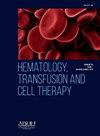老年人弥漫性大b细胞淋巴瘤在资源有限的环境中治疗的结果
IF 1.6
Q3 HEMATOLOGY
引用次数: 0
摘要
目的老年弥漫性大b细胞淋巴瘤(DLBCL)的治疗具有挑战性。低收入和中等收入国家(LMICs)关于老年DLBCL的数据有限。我们根据患者的社会经济地位分析了DLBCL患者的表现和生存结果。方法:本研究为2015 - 2023年的多中心回顾性研究。我们纳入了176名年龄在60岁或以上的患者。检查的变量包括年龄、性别、亚型、资源环境和接受的治疗。为整个患者队列创建Kaplan-Meier曲线;采用t检验比较均值、无病生存期(DFS)和总生存期(OS),显著性水平为p <;0.05. 采用SPSS 29版进行分析。结果患者中位年龄66岁(范围60 ~ 89岁)。93名(57%)患者在资源有限的环境中接受治疗,而43%的患者在资源增强的环境中接受治疗。ECOG表现得分在2 - 3分之间的占71%。IPI得分中位数为3。51% (n = 81)患者采用RCHOP方案,20% (n = 32)患者采用CHOP方案。21% (n = 38)因复发/难治性疾病而给予挽救性治疗。本组患者均未接受自体干细胞移植巩固治疗。整个队列的OS为12个月,DFS为8个月。OS (33.9% vs. 8.2%;p = 0.00)和DFS (29% vs. 5.9%;P = 0.00)。在强化环境中治疗的患者的中位生存期为1.3年,而在资源有限的环境中为0.4年(p <;0.0001)结论在资源有限的环境中接受治疗的患者生存率较低。早期转诊和纳入利妥昔单抗可改善预后。加强老年评估以及更好的支持性护理至关重要。本文章由计算机程序翻译,如有差异,请以英文原文为准。
OUTCOMES OF DIFFUSE LARGE B-CELL LYMPHOMA IN OLDER ADULTS TREATED IN RESOURCE-CONSTRAINED SETTINGS
Objective
Treating Diffuse Large B-Cell Lymphoma (DLBCL) in elderly patients is challenging. There is limited data available from Low- and Middle-Income Countries (LMICs) on elderly DLBCL. We analyzed the presentations and survival outcomes of patients with DLBCL according to their socioeconomic status.
Methodology
This was a multicenter retrospective study conducted from 2015 to 2023. We included 176 patients aged 60 years or older. The variables examined were age, gender, subtype, resource environment and treatment received. Kaplan-Meier curve was created for the entire patient cohort; t-test was utilized to compare means, Disease-Free Survival (DFS) and Overall Survival (OS), with a significance level of p < 0.05. Analysis was performed using SPSS version 29.
Results
The median age was 66 years (range: 60–89 years). Ninety-three (57%) patients were treated in limited resource settings, while 43% had enhanced resources. ECOG performance scores between 2 and 3 were present in 71%. Median IPI score was 3. RCHOP regimen was administered to 51% (n = 81) patients, and CHOP regimen to 20% (n = 32) patients. In 21% (n = 38) salvage treatment was given due to relapsed/refractory disease. None of the patients in this group received consolidation with autologous stem cell transplant. The entire cohort’s OS was 12-months, while DFS was 8-months. OS (33.9% vs. 8.2%; p = 0.00) and DFS (29% vs. 5.9%; p = 0.00) were better in patients with enhanced resources. The median DFS of patients treated in enhanced settings was 1.3-years versus 0.4-years in limited resource settings (p < 0.0001)
Conclusion
Survival rates were lower for patients receiving treatment in resource-limited settings. Outcomes can be improved with early referral and inclusion of Rituximab. Enhanced geriatric assessments along with better supportive care is essential.
求助全文
通过发布文献求助,成功后即可免费获取论文全文。
去求助
来源期刊

Hematology, Transfusion and Cell Therapy
Multiple-
CiteScore
2.40
自引率
4.80%
发文量
1419
审稿时长
30 weeks
 求助内容:
求助内容: 应助结果提醒方式:
应助结果提醒方式:


